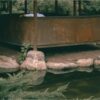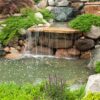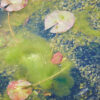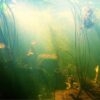Beautiful ponds are something that never leaves you indifferent. Everyone loves to enjoy the beauty of the water, but if you want to make that area peaceful and relaxing, it is necessary to remove pond sludge regularly.
What is Pond Sludge?
Pond sludge is an accumulation of organic debris that settles in the pond bottom. Usually, it is a mixture of fish waste, dead algae, decaying plants, and debris of the leaves. Sludge is an inescapable problem for pond owners, except when found in traces and small quantities.
However, problems will begin when the pond contains a lot of sludge which forms a layer on the pond’s bottom and has an unpleasant odour. The main problem is that many people don’t always understand what pond sludge is, how it occurs, and what they can do to keep it under control.
Taking the steps to keep the muck away will help you maintain a healthy and visually appealing pond. A clean pond is a nice addition to your yard and while cleaning sludge from the bottom of it can be tough work, the result will be worth your effort.
Why Does Sludge Have Bad Odor?
The sludge is the organic matter present around and in the pond, which begins to rot when it falls to the bottom. When you have a small quantity of debris in the pond, this process may be barely noticeable, but the sludge becomes impenetrable to oxygen as time goes on. The bacteria in the pond produce Hydrogen Sulphide, which smells like rotten eggs. Hydrogen Sulphide is toxic, and it kills aerobic bacteria, which are responsible for breaking down organic debris and algae.

In essence, pond sludge contributes to the process of algae blooming as there aren’t sufficient amounts of beneficial aerobic bacteria that would decompose organic debris and keep up with the rate of algae growth. The lack of bacteria will lead to a situation where fishes and pond plants will not have the necessary living conditions, and very soon, they will start dying and lead to an increase in pond sludge.
Remove Pond Sludge With a Pump
One way to clean your pond and remove all muck that lies on the bottom of it is to use electrical pumps. However, if you want to have satisfying results, you will have to know where to instal it.
Ponds should be designed so that all waste is collected at the deepest point, and that’s where the pump should be placed. Their job is to pick up the waste and pump it to the filter at the side of the pond, from where it can be cut off easily.
How to Clean the Pond Without Draining the Water?
Prevention is always better than cure. Although you might think the only way to clean your pond is to drain all the water from it, there are many tactics that can help you achieve desired results much easier. To ward off or to minimize the amount of sludge is simple and it will help you keep the good quality of water in your pond.
Tips To Remove Pond Sludge
- For example, if your pond is located next to the lawn, ensure that the grass does not fall into it when mowing because grass cuttings will quickly sink to the bottom. Even if this happens, it is essential to remove all floating debris as soon as you see them. This way, you will not wholly prevent pond sludge, but you will reduce the muck level and mitigate the potential harmful effects.
- Adding beneficial plants around your pond can prevent dirt, grass, leaves, and debris clippings from making their way into the pond. It’s easier to clean up this debris around the pond’s edge than cleaning out the sludge.
- In case you have a large pond, you will have to regularly skim off the pond’s surface to reduce debris deposition.
- Also, feed the fishes properly. Overfeeding the fish can be a significant problem because of the uneaten food.
- You also should limit the number of fishes in your pond. If there are too many of them, you will have a lot of waste, which will lead to more sludge. Also, they will not have enough oxygen, so this can cause fishes to die.
What is The Best Time to Remove the Sludge from The Pond?
To clean the pond, wait until the weather warms up as the good bacteria work better in warmer temperatures. Also, you can buy cold weather pond sludge removers.
Spring:
The best time for cleaning the pond is from spring ‘’until the end of autumn. In spring, when the water temperature starts to rise, we recommend thinning out of pond plants, removing any floating debris, and inspecting the pump filter.
Autumn:
During autumn, a more intensive clean can be carried out. You can put a net over the pond especially during the autumn months, and save the pond from debris of leaves falling off the trees.Use a coarse net with a strong handle and draw it across the base of the pond until it’s clear.
If small particles are still present in the water, draw a finer net through the midwater, removing as much dirt as you can. Also, you need to remove dropped tree and shrub branches and the majority of their leaves before they start to decay after they sink. With a pond vac, you will ensure clean of the sides and bottom of the pond.
Winter:
After the fall, winter is coming, and that is a safe hibernation period for the fish. To prevent muck build-up from making sure that pond plants are in the right place, covering in the gravel, and tie them in winter. If the debris contains mostly non-decay leaves, you may be able to remove them by scooping them out with a pond net. This is usually quite enough to start.
Skimmers, Shovels and Vacs To Remove Pond Sludge
Pond Skimmers
If trees surround the pond, then it would be worth investing in a pond skimmer that can collect the debris and not allow any of it to sink and decay on the bottom. For smaller ponds, you can choose floating or submerged skimmers. For larger ponds, we recommend box skimmers. They will keep the surface clear and remove finer debris that nets may miss.
Shovels
Also, it will be necessary to remove the sludge from the bottom of the pond. You don’t need to remove everything; it is best to eliminate as much as possible to provide your fish a safe hibernation period in the pond. Specifically, there are shovels to help you take away sediment or sludge from a pond. It can be hard but not expensive work, and it can be a good option for a small pond. You can leave muck from the pond at the water’s edge on the day you remove it. After a few days you will get great compost and garden fertilizer.
Pond Vacs
Pond vacs are like regular, household vacuum cleaners, except that these work with pond debris and water. Most models are placed on dry land at the side of the pond, and a pipe is used to reach the sides and bottom of the pond and it will pull water with sludge from the pond. The best part is that there is no need to move the fish from the pond and drain the pond.
The most common pond vac type is set up to muck removed water straight down the drain. Other types trap the sludge in a container or bag. For larger ponds, use a pump-powered model and, for smaller ponds, the hose-powered models.
The essential thing is never to vacuum during the summer when insects and amphibians are reproducing. If you’re worried that they will suck up something living and small, fit a sludge bag or detritus collector to the waste hose. Vacuum your pond regularly, and water will be healthier.
What to Do After the Cleaning The Pond Sludge?
After clearing out the sludge from the bottom of the pond, before carrying out maintenance on the pond filter, it’s better to wait a couple of weeks.
- Some beneficial bacteria have been lost during the cleaning process, so you allow the bacteria to build back up to full levels when you wait a while.
- You should clean the filter as soon as you notice a water drop flow from the filter outlet pipe. To keep the filter in good condition and fully operational, you should need to clean it a few times per year.
- Sponges should be rinsed in a bucket of water when taken from the pond. This way, you will save the beneficial bacteria that break down the fish waste. Keep in mind that the filter doesn’t have to be spotlessly clean.
- After the filter cleaning is complete, it is good to add an additive that will give the bacteria development a boost. Don’t forget to check up on your pond filter at least once a month.
Does Algae Causes The Sludge In The Pond

Algae needs to be controlled so that it doesn’t destroy plant life, reduce the oxygen level in the pond, or cause water quality issues. Small amounts of algae are natural and beneficial for goldfish and insect larvae. Algae can grow uncontrolled, where it rapidly spreads and takes over the entire pond and that can be a problem.
If the algae smother the pond plants, there will be more sludge on the bottom, and the oxygen level in the pond will reduce as bacteria work to break down this waste. A pond vac will work on tackle algae, and a UV clarifier can be installed to tackle the green water. Algae may also be controlled by adding more plants, as these will compete with the algae for the nutrients in the water, so the growth of algae will be slower.
You don’t have to worry whether sludge removers will harm your pond. They are healthy bacteria, and there are no chemicals involved. It can take up to two weeks before real results, depending on how much sludge is left in the pond.
When you find that the pond sludge is under control and you have successfully remove the pond sludge, there are precautionary measures that you can take so that it does not get to a harmful level again. It is a good idea to have a pond net that will stop some of the unwanted debris.
Is it Good to Drain the Pond Completely?
To fully drain a pond in order to clean it is usually not necessary, and it should be done only when there are no other options. If the sludge becomes a few inches thick or you are unable to solve the issue with the other methods then you need to resort to complete cleaning of the pond.
This is not the best choice because it destroys the balance in place and restarts the pond ecosystem from scratch. If you need to do this you will need to find temporary housing for the fishes or frogs. You can use a sump pump or to remove the bulk of the water and then a vacuum to remove the sludge from the bottom.
By removing the pond water, you will also remove the beneficial bacteria which break down fish wastes and make the water safe for life. The best choice is to retain as much existing water as you can to preserve the micro-organisms population.
When you start topping up new water, it is necessary to dechlorinate it. It would be best to use rainwater, you can use a holding tank to keep as much of the water that you can. In the end, don’t use a power washer to blast away all the algae. As long as you have the right equipment, and conduct regular pond maintenance, general cleaning is rarely a necessity.
Turbid Pond Doesn’t Always Mean Poor Water Quality
Even if pond water looks green or dirty, it doesn’t always mean it needs to be drained due to poor quality. Water that appears turbid can be very healthy and works with the pond’s ecosystem to provide a natural cleaning service. Pond water contains microorganisms and beneficial bacteria that break down harmful substances, such as nitrates and ammonia. These help keep the pond in balance.
Cleaning a pond without draining it will ensure that natural water balance is preserved, allowing them to continue providing bio-filtration after the waste is removed. If waste levels get high, you will need to manually remove them so bacteria can get back to work again. As we said before, you don’t need total drainage. By following these tips, you will be able to keep the sludge away from your pond and clean it easily and hassle-free.









